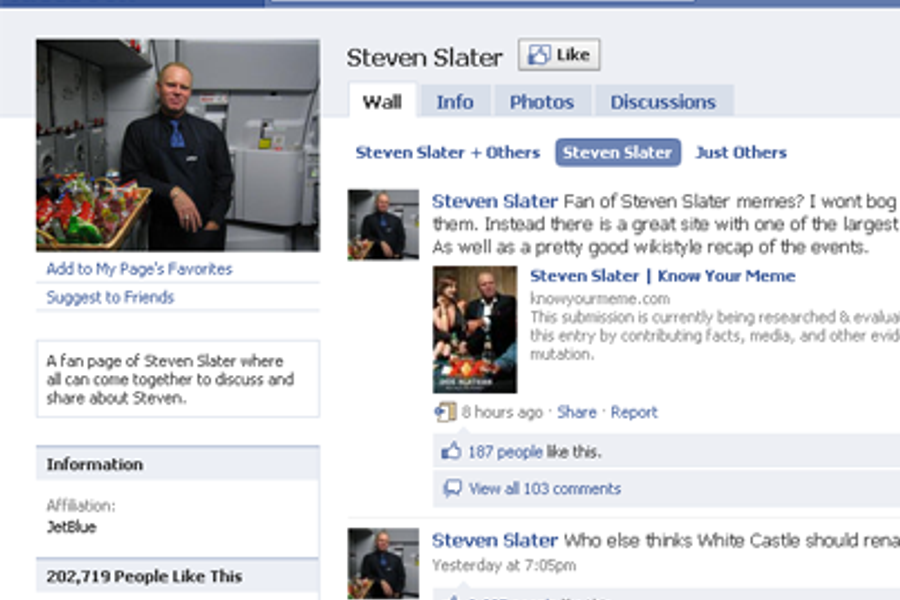
In the wake of flight attendant Steven Slater’s notorious exit on Aug. 9, Jet Blue released a defensively flippant statement on its blog smirking that “you can’t make this shtick up.” (By Wednesday afternoon, the site appeared to be taken down or overloaded).
But Slater’s can’t-take-it-no-more farewell and the circumstances leading up to it highlighted serious labor and safety issues facing flight attendants and the passengers they serve, not to mention the fact that so many people worldwide feel abused, exploited and disrespected at their jobs, as evidenced by Slater’s immediate ascendancy to international “folk hero.”
Slater called it quits after an altercation with a disobedient passenger trying to take a bag out of an overloaded overhead compartment; and he reportedly also tangled with the same passenger earlier when bags were being stuffed in.
The Association of Flight Attendants (AFA-CWA) union has for months been protesting to federal regulators and legislators and the general public that fees for checked baggage have meant overstuffed overhead compartments dangerous for passengers and even more so for flight attendants.
The carry-on issue is just one example of the way the nation’s nearly 100,000 flight attendants have seen their jobs get more grueling, unpleasant and dangerous even as their pay and benefits have been cut.
Cost-cutting airline policies like checked bag fees, overbooking, rerouting and the like affect flight attendants from the top, so to speak, as well as from the bottom as irritated passengers take out their frustrations on them.
In March, the AFA-CWA union released a study of 50,000 members at 22 airlines showing more than 80 percent of flight attendants had been injured by falling baggage.
One out of two flight attendants witnessed carry-on items falling from overhead bins in the previous 60 days. The survey validated anecdotal reports that carry-on baggage is out of control, mostly due to recent fees to check luggage.
The union also reported that in 1996, long before the current bag crisis, “as many as 4,500 passengers and 3,600 flight attendants a year are injured by falling carry-on bags.”
Government websites note that flight attendant is a rough job. The Bureau of Labor Statistics says that:
Full-time flight attendants experienced a much higher than average work-related injury and illness rate. Various physical injuries can occur when opening overhead compartments or while pushing heavy service carts. In addition, medical problems can arise from irregular sleeping and eating patterns, dealing with stressful passengers, working in a pressurized environment, and breathing recycled air.
California’s Employment Development Department website notes:
A Flight Attendant’s job is both physically and emotionally demanding. Flight Attendants are on their feet during most of the flight and under pressure to complete their tasks within the scheduled flight time. At times they have to serve meals and pour drinks under turbulent flying conditions. Despite stress or fatigue, they are expected to deal pleasantly with passengers of all personality types, including those who are difficult or rude. Although Flight Attendants enjoy the benefits of travel, they also may have to live out of suitcases for weeks at a time. They may be scheduled to fly at any hour, weekends and holidays.
The side benefit of on-the-job travel and free or reduced cost extracurricular flights is a big incentive for many flight attendants. But starting pay can be literal poverty wages (average $16,000) and overall median pay of $35,000 is certainly not generous especially considering the long hours involved. The BLS notes 12 hour shifts are standard, and flight attendants may work up to 14 hours at a time, with nine consecutive hours of rest mandated during a 24-hour period.
Most flight attendants are unionized, the majority with the AFA-CWA, Teamsters or Independent Federation of Flight Attendants. Airlines are known for extreme combativeness and obstinance during contract negotiations. The public got a window into the frightening and ugly side of airline labor practices after a February 2009 crash near Buffalo. It turned out co-pilot Rebecca Shaw earned so little – just $16,000 a year – that she lived with her parents literally across the country from her work base. She like many pilots and doubtless flight attendants commute overnight before starting their shifts.
The airline industry and legislators went from celebrating to stonewalling pilot Sully Sullenberger of “Miracle on the Hudson” fame after he used his newfound celebrity to talk about such issues.
Who knows if it says anything about Jet Blue’s attitude toward their own employees that their Slater blog thanked their “2,300 fantastic, awesome and professional inflight crewmembers” — but an online commenter pointed out they have 2,700 such employees.
While abusive and irascible passengers like the one whose bag injured Slater are a common sight, the response to Slater’s act and subsequent arrest show that many in the general public do indeed appreciate the valiant efforts of flight attendants. Comment sections of news stories and on-line support groups (for example, here and here) are overflowing with international messages of support, often praising Slater for having the guts (or balls) to do what so many would like to. Comments included:
JAIL employers who force employee to be treated as slaves by their “customers”
Job well done…you said what millions of people would love to say but dont have the courage to do so!!!!Steven, you had the courage to do something many people only dare to fantasize about… Countless people are on your side!
Kari Lydersen is a Chicago-based journalist, author and assistant professor at Northwestern University, where she leads the investigative specialization at the Medill School of Journalism, Media, Integrated Marketing Communications. Her books include Mayor 1%: Rahm Emanuel and the Rise of Chicago’s 99%.








